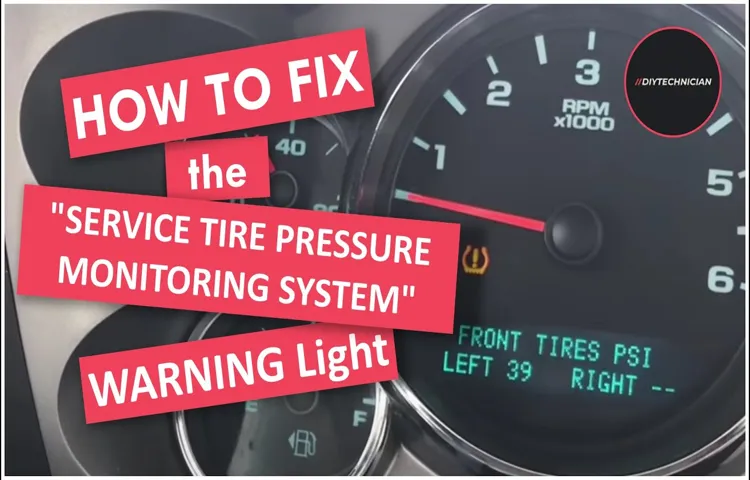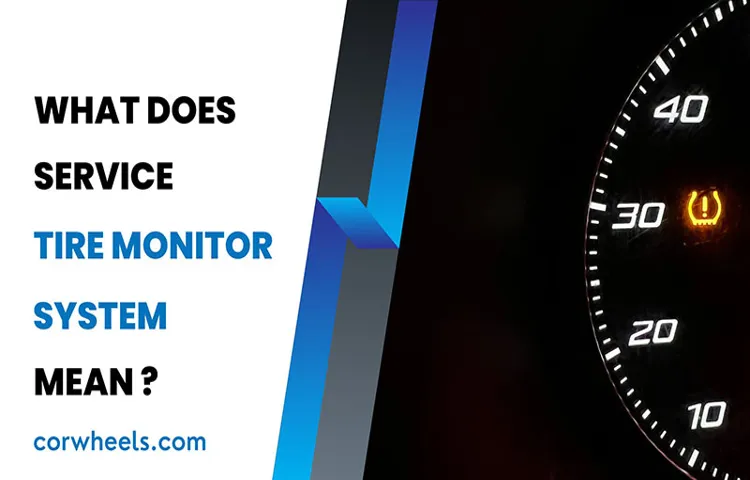Have you ever noticed a warning light on your car’s dashboard that reads “Service Tire Monitor System”? If so, you might be wondering what this means and whether you need to take your car in for service. The Tire Monitor System is an important feature found in many modern cars, designed to help keep you safe on the road by alerting you when your tires need attention and potentially preventing accidents caused by low tire pressure. In this blog post, we’ll take a closer look at what the Service Tire Monitor System is, how it works, and what you should do if you see this warning light on your car’s dashboard.
So buckle up and let’s get started!
Table of Contents
Understanding Your Car’s Tire Pressure Monitoring System
If you see a message that says “service tire monitor system” on your car, it likely means that there’s an issue with your tire pressure monitoring system. This system is designed to monitor the air pressure in your tires and alert you if it falls below a certain threshold. A “service tire monitor system” message could mean that one or more of your sensors is malfunctioning, or it could simply indicate that your tires need to be inflated.
Either way, it’s important to address this issue as soon as possible to ensure that your tires are properly inflated and you’re driving safely. In some cases, you may be able to reset the monitoring system on your own, but if the problem persists, you should consult with a professional mechanic who can diagnose and repair the issue. Remember, properly inflated tires not only ensure your safety on the road but can also improve your car’s fuel efficiency and extend the life of your tires.
How the System Works
The tire pressure monitoring system (TPMS) in your car works by constantly monitoring the air pressure in each tire and alerting you if it drops below a certain level. This measurement is done using sensors on each tire that communicate with the car’s computer. The TPMS warning light will illuminate on your dashboard if any tire’s pressure drops below the recommended level, which is typically set by the vehicle manufacturer.
Ensuring that your tires are properly inflated is crucial for safety and the longevity of your tires. Underinflated tires can cause poor handling, decreased fuel efficiency, and even tire failure. Keeping an eye on your TPMS and taking action if the warning light appears can help prevent these issues.
Remember to check your tire pressure regularly using a tire pressure gauge and inflate them to the recommended level, as the TPMS serves as a safety net but isn’t a substitute for regular tire maintenance.

Why the Service Tire Monitor System Message Appears
A Service Tire Monitor System message can appear on your car’s dashboard, indicating that there might be something wrong with your tires. This message might seem alarming, but it’s simply an alert that your car’s Tire Pressure Monitoring System (TPMS) has detected an issue. Your car’s TPMS is designed to monitor the tire pressure and inform the driver if the pressure falls below the recommended level.
Modern cars come with a TPMS system that can detect any discrepancy in tire pressure and notify the driver. Tire pressure is essential in optimizing fuel economy and safety on the road. Low tire pressure can result in a loss of traction, leading to accidents, and negatively affect fuel consumption.
Therefore, it’s essential to act promptly when you receive the Service Tire Monitor System message. In cases where the tires are punctured or damaged, the message is a clear indication that you need to fix or replace them before continuing to drive. Regular tire pressure checks are crucial to avoid this issue altogether and keep your vehicle running smoothly on the road.
What to Do When You See the Message
If you see the message “service tire monitor system” pop up on your car, it means that your tire pressure monitoring system (TPMS) needs maintenance. The TPMS is responsible for sending a warning to your car’s computer when tire pressure is low or when there’s a problem with the tire sensor. This message can show up if there is an issue with one or more of your tire sensors, or if there’s a problem with the TPMS itself.
It’s important to take this message seriously and have your car serviced as soon as possible. Driving with low tire pressure can be dangerous and can lead to excessive tire wear, decreased fuel efficiency, and even blowouts on the road. Schedule an appointment with a certified technician who can diagnose and fix the problem, so you can continue driving safely on the road.
Check Your Tire Pressure
Tire Pressure Have you ever seen the message pop up on your car dashboard indicating low tire pressure, and wondered what you should do about it? One of the most important things you can do for your vehicle is to regularly check your tire pressure. Low tire pressure can cause poor fuel economy, reduce tire life, affect vehicle handling and performance, and even lead to a dangerous blowout on the road. To check your tire pressure, first, locate your vehicle’s recommended pressure levels listed in the owner’s manual or on the tire information placard located on the driver’s side doorjamb.
Next, use a tire pressure gauge to measure the air pressure in each tire and inflate or deflate as needed to match the recommended levels. Checking tire pressure should be done monthly, or more frequently in extreme temperature changes. Maintaining proper tire pressure not only keeps you safe on the road, but also saves you money in the long run by increasing fuel efficiency and prolonging tire life.
Inspect Your Tires for Damage
Inspecting your tires for damage is an essential part of vehicle maintenance. It’s essential to understand what to do when you see a message on your car indicating a tire problem. Most modern cars have a tire pressure monitoring system that will alert you if there’s an issue with the tire’s pressure.
If you get this notification, it’s essential to inspect your tires. Look out for cuts, punctures, or bulges, and if you notice any of these issues, replace the tire immediately. Driving with a damaged tire can result in a blowout, which can cause an accident.
Additionally, ensure that your tire tread depth is proper, as worn-out tires can affect your car’s handling and braking. The keyword utilized naturally is tire damage. So, whether you’re inspecting tires on your own or taking your vehicle to a professional, stay safe and act promptly.
Reset the System
If you see the message to reset the system, don’t worry – it’s not as daunting as it sounds! Sometimes the system can become overloaded or experience a glitch, which is when this message typically appears. To reset the system, simply turn off your device and unplug it from the power source for a few minutes. This will allow the system to completely shut down and reset itself.
Once you plug it back in and turn it on, the message should no longer appear and you can resume using your device as normal. Think of it like taking a quick break to clear your head!
Why Ignoring the Message is a Bad Idea
If your car is displaying the message “service tire monitor system,” it’s important not to ignore it. This message indicates that there’s an issue with your vehicle’s tire pressure monitoring system, which is designed to warn you when the air pressure in your tires is too low. Low tire pressure can negatively impact your vehicle’s handling, fuel efficiency, and safety, so it’s crucial to address the issue promptly.
The problem could be something as simple as a faulty sensor or a leaky tire, but it’s important to have it checked out by a qualified mechanic. Ignoring this message could have serious consequences, so stay safe and get your tire monitor system serviced as soon as possible.
Safety Risks of Driving with Low Tire Pressure
Driving with low tire pressure is not only a hassle, but it can also be incredibly dangerous. It’s understandable why some drivers may choose to ignore the warning message on their dashboard, but the risks just aren’t worth it. When your tires are underinflated, they become more susceptible to damage and can even blow out while you’re on the road.
This can cause loss of control and accidents that can result in serious injury or even death. In addition, low tire pressure can lead to decreased fuel efficiency and increased wear and tear on your tires. So, when that warning light appears, it’s important to take action and make sure your tires are properly inflated.
It may seem like a hassle, but it’s a small inconvenience compared to the potential risks of driving with low tire pressure.
Long-Term Effects of Ignoring the Message
Ignoring the message may seem like an easy way out of a difficult situation, but the truth is that it can have serious long-term effects. When we ignore messages, whether they come from our friends and family, our co-workers, or our own bodies, we risk missing out on important information that can help us make better decisions and avoid mistakes. For example, if we ignore our bodies when they tell us that we are overworked or under too much stress, we risk developing chronic health problems over time.
If we ignore feedback from our co-workers, we may miss out on opportunities for growth and development in our careers. And if we ignore messages from our loved ones, we may damage our relationships and miss out on the many joys and rewards that come from close connections with others. In short, ignoring the message is a bad idea that can have serious long-term consequences.
Instead, we should pay attention to the messages we receive and take action accordingly, whether that means seeking medical help, listening to feedback, or communicating openly with the people we care about. By doing so, we can avoid many of the negative effects that can arise from ignoring the message.
Final Thoughts on Service Tire Monitor System Message
If your car displays a message that says “Service Tire Monitor System,” it means that there may be an issue with the tire pressure monitoring system in your vehicle. This system is designed to detect and alert you when your tire pressure is low, which can help prevent accidents and improve fuel efficiency. When the system detects an issue, it will trigger a warning message on your dashboard.
Don’t ignore this message – it’s important to get your system checked and serviced as soon as possible. Driving on underinflated tires can be dangerous and can cause damage to your vehicle. Make sure to have a professional technician inspect your tire monitoring system to ensure that it’s functioning properly.
Taking care of this issue promptly can help keep you safe on the road and prevent more extensive repairs down the line.
Conclusion
In short, when your car says “service tire monitor system,” it’s like your car is telling you, “Hey, it’s time to give your tires some T-L-C.” Think of it as a friendly reminder to make sure your tires are properly inflated and in good shape. So, don’t ignore this message, because a well-maintained tire monitor system ensures a smooth and safe ride for you and your passengers – and that’s worth more than a few minutes of inconvenience at the mechanic.
“
FAQs
What is the tire monitor system in my car?
The tire monitor system is a feature in your car that monitors the air pressure in your car tires and alerts you if there is an issue.
What does it mean when my car says “service tire monitor system”?
It means that there is a problem with the tire monitor system in your car and it needs to be checked and serviced by a professional.
Can I still drive my car if the “service tire monitor system” message is displayed?
Yes, you can still drive your car, but it is recommended to get it checked as soon as possible to avoid any issues with your tires.
How often should I check my car’s tire pressure?
It is recommended to check your car’s tire pressure at least once a month or before any long drives.
What are the consequences of driving with low tire pressure?
Driving with low tire pressure can lead to decreased fuel efficiency, poor handling, and increased risk of tire blowouts and accidents.
How can I fix the “service tire monitor system” message in my car?
You can fix the issue by checking the tire pressure yourself or taking your car to a professional who can diagnose and fix the issue.
How much does it cost to service the tire monitor system in my car?
The cost can vary depending on the issue and the make and model of your car. It is recommended to get a quote from a professional before getting the service done.



